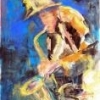-
Posts
10 -
Joined
-
Last visited
Reputation Activity
-
 pranfeuri got a reaction from PhotoMich in People -- Anything about People (Open Thread)
pranfeuri got a reaction from PhotoMich in People -- Anything about People (Open Thread)
Posing at a bridge
X70 f5.6 1/500 ISO200
-
 pranfeuri reacted to Trenton Talbot in Night photography
pranfeuri reacted to Trenton Talbot in Night photography
Accidental selfie in the night forest. X-T1, XF14mm, 2 flashes, 1 light wand.
I was actually just checking the key light…
-
 pranfeuri reacted to Trenton Talbot in Night photography
pranfeuri reacted to Trenton Talbot in Night photography
Moonlit pines. X-T1, XF14mm @ f/8, 15 minutes from the tripod.
-
 pranfeuri got a reaction from milandro in People -- Anything about People (Open Thread)
pranfeuri got a reaction from milandro in People -- Anything about People (Open Thread)
Posing at a bridge
X70 f5.6 1/500 ISO200
-
 pranfeuri reacted to HendrikOsula in Streetphotography (open thread)
pranfeuri reacted to HendrikOsula in Streetphotography (open thread)
Morning Glow @Tallinn, Estonia by Hendrik Osula, on Flickr
X-T2 + 50-140/2,8
-

-
 pranfeuri reacted to Enzio in Fuji butterflies
pranfeuri reacted to Enzio in Fuji butterflies
with the Takunar 50/4.0 Macro ... :cool:
C-Falter by Enzio Harpaintner, auf Flickr
-
 pranfeuri got a reaction from Enzio in Fuji butterflies
pranfeuri got a reaction from Enzio in Fuji butterflies
Took this one with my X70 on a mountain top in Corfu.
-
 pranfeuri got a reaction from George_P in Fuji butterflies
pranfeuri got a reaction from George_P in Fuji butterflies
Took this one with my X70 on a mountain top in Corfu.
-
 pranfeuri reacted to Warwick in Scotland with the X-Pro 2
pranfeuri reacted to Warwick in Scotland with the X-Pro 2
A couple from Scotland with my XPro2
Glencoe (XF50mm)
Camusdarrach beach, near Mallaig (XF23mm F2)
Hills above Glen Nevis (8mm fisheye)
Sent from my iPhone using Tapatalk
-
 pranfeuri reacted to bhu in What is the difference between shaddows and dynamic range
pranfeuri reacted to bhu in What is the difference between shaddows and dynamic range
"Shadow" settings adjust gamma near the dark end of the luminance range. This is typically used to artificially increase luminance in low-luminance areas so you can see more detail in dark areas when the image is reproduced. Shadow enhancement can be applied to any photograph, even photo's taken with "DR" enhancement. Those settings usually just re-map gray levels. For example, gray levels 1, 2, and 3 may be re-mapped to gray levels 2, 4, and 6 making them artificially brighter.
Dynamic range is supposed to be an increase in the sensor's range of counting photons. That is, if a pixel element in the sensor needs 10, or more, photons to be not-black and 10,000, or fewer, photons to be not-white (saturated), the dynamic range is 1000:1. Now, say that some new sensor may be able to read only 5 photons for not-black and can accept 50,000 photons for not-white resulting in 10,000:1 dynamic range. True dynamic range is a function of the photo-receptors on the camera's sensor.
Please note that dynamic range has nothing to do with bit-depth - the number of gray levels. Bit-depth simply divides the sensor's operating range of detectable luminance into gray levels. A sensor with 1,000,000:1 dynamic range can have an 8-bit per color conversion or a 14-bit per color conversion but you should expect the 8-bit to show gradations, or lines, where the photon count breaches the next gray level. Spacial dithering can help smooth "chunky" gray levels but the best way is, obviously, to add more bit-depth, which divides the sensor's luminance range into finer and finer slices.
There are ways of fudging this, though, so beware of the difference between true dynamic range and "features" that call themselves Dynamic Range, or DR. Fujifilm has been adjusting gain in pixel elements so that, even if the element's range is small, the range can be moved, shifted, so that some elements are "tuned" to be more sensitive and some are "tuned" to be less. This technique effectively increases a picture's dynamic range at the cost of... spacial dithering; that is, half the pixels scattered throughout the image may be exposed more, leading to blooming in bright areas just to capture detail in dark areas, while the other pixels might be less exposed to preserve detail in bright areas at the cost of losing detail in shadows.
Using a DR setting sprinkles darker pixels in with brighter ones to (theoretically) increase the dynamic range of the picture (but not individual pixel elements). (I said, "theoretically," because the increased dynamic range must be saved in the picture, then reproduced on some media capable of showing it.) There is nothing inherently wrong with this approach and it can actually aid in giving a photo film-like grain.\
Of course, there is another way to increase dynamic range: Take two photographs with different exposure settings and overlay them. That is the common "HDR" stuff you read about. Typical HDR photography increases dynamic range by using temporal dithering (in a very simplistic sense).
Shadow enhancement can be applied to any photograph, even photo's taken with "DR" enhancement. Those settings usually just re-map gray levels. For example, gray levels 1, 2, and 3 may be re-mapped to gray levels 2, 4, and 6 making them artificially brighter.
-
 pranfeuri reacted to BobJ in What is the difference between shaddows and dynamic range
pranfeuri reacted to BobJ in What is the difference between shaddows and dynamic range
It's not a stupid question Pranfeuri. In a nutshell then, here goes. Dynamic range is a term used in electronics. In a camera it is used to describe the brightness range from the deepest shadow tone that can be distinguished from noise to the brightest tone that can be recorded before the sensels become saturated and cannot convert any more photons. In ye olden days when I used film the equivalent was known as the films latitude. An analogue to digital converter is used in the camera to digitise the output from the sensor and can usually give a 14 bit wide digital output. Jpegs are only 8 bit so they cannot include all those tones. However 8 bits are enough to describe all the tones that a monitor, tablet etc can display or a that print can reproduce. Therefore we have the opportunity to compress the 14 bits into 8 bits using what is known as the tone curve. The algorithm in the camera does this for us but may need altering for some images. The DR and shadow and highlight settings in the Fuji cameras can be used to do this. Basically the DR settings underexpose so as not to blow the highlights and boost the mid and shadow tones to fit in. The shadow and highlight adjustments change the tone curve to make them darker or lighter as required. Of course if you use raw then you can decide afterwards how to fit the tones in. That is one of the main advantages of raw. With the latest sensors it's amazing how much detail can be rescued from the shadows before noise becomes a real issue.
-
 pranfeuri reacted to adzman808 in Why do I prefer my x-pro1's images over my x-pro2's?
pranfeuri reacted to adzman808 in Why do I prefer my x-pro1's images over my x-pro2's?
X-Pro2 on the left
This is from RAW
+1/3 of a stop exposure and minus one notch in SilkyPix's contrast slider and the difference between them isn't so much.
Don't ask me how to replicate the SOOC Jpegs though!
That said I suspect that Pugsley47's suggestions RE the shadow/highlights won't be far off the mark
-

-

-
 pranfeuri reacted to jmai86 in Ken Rockwell is unimpressed
pranfeuri reacted to jmai86 in Ken Rockwell is unimpressed
Ken is a bit hyperbolic, and his views are often a bit out of touch, but I'm still glad his website exists, for several reasons.
- His product photography is top notch, and a valuable resource for me in checking out new gear in glorious detail.
- His "reviews" have info that I can easily glean, that I cannot get in a consistent manner anywhere else. # of aperture blades, consistent flare, sunstar, macro testing, etc.
- He is obviously passionate about what he does, and I can't fault a man for that. Whether his views agree with mine are irrelevant. \
- The target audience for his blog is not you or me, it is for the average consumer. When viewed in this light, his "reviews" make a little more sense.
All that being said though, I will readily agree that his skill is lacking and his views on photography to be head scratching very often. I cringe at the photos he produces, all crunched through Perfectly Clear and totally destroyed.
Also, I'm new to the forum! Hello!
-
 pranfeuri reacted to deva in Ken Rockwell is unimpressed
pranfeuri reacted to deva in Ken Rockwell is unimpressed
I find Ken's reviews helpful... not so much his personal conclusions, but the info he provides. When I first tried my X-Pro2, I discovered the same thing. The auto brightness on the EVF is crap. It goes from washed out to too dark. I turned it off and have left it off since.
He is also right about the area af focus. I mostly shoot single focus point because it too often gets it wrong.
I read a number of X-Pro2 reviews that did not mention these things. His review of the good and bad about the X-Pro2 is accurate. Now all his stuff about who a pro is, what they want, and his subjective conclusions, I mostly consider to be noise in otherwise useful reviews.






